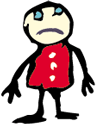
The
Natural Destiny
of
the
Bloomington Baby
By Lisa Blumberg.
Lisa Blumberg writes about eugenics issues.
He would have presumably been a member of the high school class of 2000. He might have been planning to go on to community college, art school or trade school. He could have been looking for a job. He might have decided to take the year off, just hang out with the guys or with a girlfriend or play video games.
All that we know for sure is that he would have had options and he would have had a name. He might have been Jeremy, Robert, Michael, Jim or Darnell.
He was known but he was nameless, the original Baby Doe. Eighteen years ago, he died in infancy of dehydration and malnutrition in a hospital in Bloomington, Indiana, the victim of a conspiracy to "allow him to die" because he had an extra chromosome.
Although society in general played some role, there were several immediate players in the conspiracy. They were his parents who were too quick to seize upon the idea that people with Down syndrome had no future, his doctors who were too willing to offer the parents the option of denying him the simple operation on his esophagus that would have let him eat normally, the hospital administrators who approved the sequestering of the baby in a dark corner so that no one on staff would give him water and nutrients by IV, and the Indiana Supreme Court which in approving a "quality of life" decision allowed the baby to be tortured to death.
There were some who tried to save him. A young man with Down syndrome called up one of the judges and said, "I want that baby to live." He was ignored. (Judges aren't supposed to be swayed by outside influences). There were dozens of offers to adopt the baby. The baby's parents were not interested. He was theirs, to dispose of.
Some of the hospital staff did deviate from the prevailing medical view. They looked for the baby, finally found him and, at some personal risk, gave him emergency care. They were too late.
There were also many people who were very, very disturbed by what was happening but felt that they could not take a stand until they figured out what type of case this was. Was it a right-to-die case? A right-to-life case? A case about parental autonomy? A case brought on by advances in medical technology? A case propelled by state interference or government cutbacks? A liberals-vs.-conservatives case?
Some of us, who had disabilities ourselves, tried hard to suppress the little voice that said, "it's about bigotry, it's about murder." Of course, we should have done something to call attention to ourselves as a group. These should have been our days of rage. However, we were a young and slowly coalescing movement in l982. We wanted our issues to be linear. Access, transportation, employment, education. These bread-and-butter concerns were difficult enough.
The baby, feverish from thirst, breathed his last but the story survived. As network news said, the baby's death sparked a range of reactions from outrage to sympathy (for the parents). What emerged from the "Baby Doe" controversy that continued for years through several spins and permutations was that there was no consensus in America that children born with disabilities should be afforded the same protection to life and limb that are afforded, albeit imperfectly, to other children. Nearly a generation later, there is still no consensus. The one difference is that people with disabilities are a bit more visible in the debate.
The baby himself has become an abstraction, a footnote to discussions. However, he is one of the movement's many dead and disability rights activists owe a debt to him. He helped toughen the movement, helped it grow up and expand its agenda. Partly because of him, we are more willing to deal with the curve ball issues, the wake-up-in-terror-at-3-o'clock-in-the-morning issues, the be-at-loggerheads-with-your-neighbors,-colleagues-and-your-allies issues. We said "Jail Jack" in l999 although we could not have murmured the equivalent in the early Eighties.
No group is more heterogeneous, more diverse than people with disabilities are. The one uniting thread we have is that we are all to some degree denied our individuality. On this, we have formed a movement.
The Bloomington baby lived our collective nightmare in more ways than one. His parents, regretting that he had even seen the light of day and choosing to doom him, declined to give him a name. So he became Baby Doe, and then later a baby doe as the media adopted that shorthand term to refer to a whole underclass of babies, the value of whose lives were speculative. Conundrum: If a baby doe is allowed to grow up, do we have an adult doe?
But the baby did see the light of day, if only reflected from grim walls. He was an individual. His natural destiny was to have a name. That was part of his stolen potential and what we can do for him now is to acknowledge that. He might have been Benjamin or Christopher, Paul, Martin or Tim.
Back to table of contents

